|
|
PLEASE NOTE: Bad copies of some of our Swords are being sold by other companies.
They are NOT from our Company and are INFERIOR in quality.
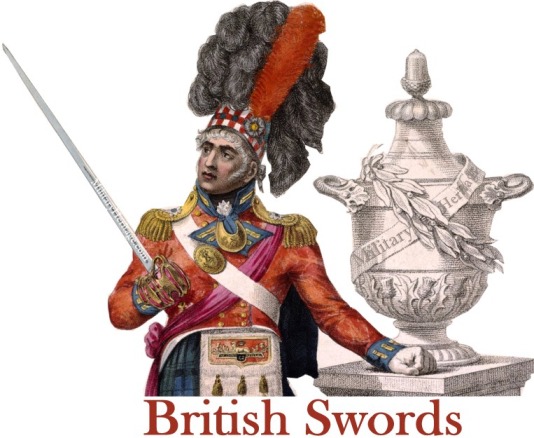
"Providing Museum Quality Swords since 1995"
![]() Yes. We Ship to the United Kingdom each Week!
Yes. We Ship to the United Kingdom each Week! ![]()
Great attention to detail and authenticity has been paid in making our military swords and sabres. As you will see, the following hand-forged, battle-ready replica swords are not only rare and beautifully constructed, but also affordably priced. Each sword blade is made of superior AISI 1065 high carbon steel and are evenly tempered and well-balanced.
Feel Safe with our MONEY BACK GUARANTEE!
FAST 5 to 7 Day UPS Shipping Anywhere in North America
(see details at bottom of page)
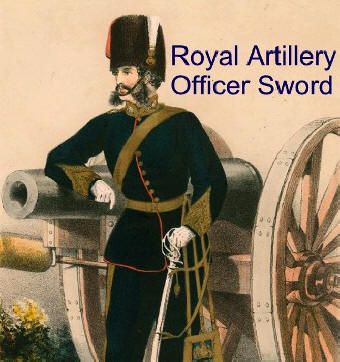
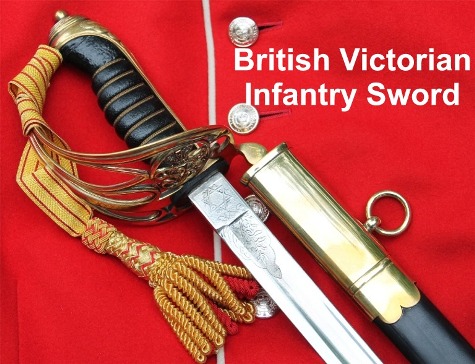
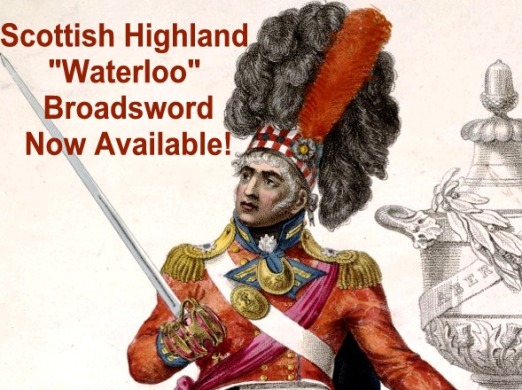

British and Canadian ERII Infantry Officer Sword

World War One Infantry Officer Sword
|
|
|
|
|
Royal Navy Officer's Sword
Used by the Royal Navy, Royal Canadian Navy, Royal Australian Navy and a whole host of other Commonwealth navies today, this excellent quality, gold-plated naval sword (including scabbard) is now available at an affordable price. First introduced in 1827, this sword even found its way into the hands of the officers of the Confederate Navy during the American Civil War. This beautiful sword is made in the gothic style with some harkening back to Nelson's times with the lion's head pommel/back strap.
The solid bowl guard is pebbled to create the illusion of negative space, and in the centre is, of course, is a crown and fouled anchor. The sword knot slot in the guard has been rounded to allow the Navy cord knot to pass through. A very nice touch is the folding rear part of the guard which latches into a stud on the gilt brass top piece of the scabbard. This latching system is requisite for Naval officer side arm especially onboard during a gale. The white imitation fish skin grip is wrapped with gilt wire to complete the look of the gold plated (gilt) hilt. Made from AISI 1065 steel, the straight blade's craftsmanship is superior with excellent tempering and balance. All the requisite etching including the Royal Coat of Arms and a crown and fouled anchor and ropes has been added. The length of the blade is 31 1/2 inches. The scabbard is one of the most impressive in our sword collection. This leather scabbard has all of its gold-plated brass hardware finely engraved to produce a very handsome overall appearance.
|
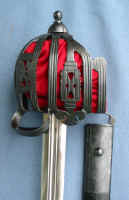 SALE
SWD-29 |
18th Century Highland Basket-hilted Sword. Many a brave Highlander who stormed across the fields of Culloden in 1746 to meet his destiny carried this sword. This style is typical of the basket-hilted swords, with its flattened and grooved detail, produced in the Glasgow Hammermen of Scotland. This design is first attributed to John Simpson, a Freeman of the Glasgow Hammermen, in the 1690s. Another John Simpson, popularized the design while serving as King's Armourer in the 1730s and 1740s. By the time of the Jacobite Rebellions this sword was likely the most common style being used in the Highlands.
As the images attest, this hand-forged reproduction is simply magnificant. The 31 1/2 inch tempered high-carbon steel blade is impressive with its wide, fullered, and well balanced construction (blade thickness: 7/32"). The 6 1/4" tall steel basket is blued, and lined with fine red wool. Historically this liner was sometimes removed. The grip is leather wrapped with copper wire. The scabbard is leather wrapped wood and with blued steel throat and chape pieces. This sword is perfect for anyone taking pride in their Scottish Heritage. Not in images but comes with red fringe on pommel, which if removable. We photographed it without as it matches the historic image above. Additional Images: Sword beside Scabbard Hilt Detail Hilt detail - front Inside Hilt Sword beside dirk and pistol |
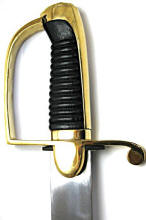
|
Royal Artillery Gunner's Sword
|
SWD-51 |
Royal Navy Dirk 1780-1815 This cushion pommel 5 ball dirk with an imitation ivory grip is ideal for any collector interested the age of fighting sail. While made to commemorate the British naval victories at St. Vincent, the Nile, Trafalgar and the War of 1812, this pattern of dirk also saw service in the U.S. Navy. It is the arm of the young midshipman, and an important secondary weapon for any naval officer in hand-to-hand fighting.
Blade: 36 cm (14 inches) Additional Images: Image Image Image Image
|
SWD-54 |
Admiral Nelson's fighting Sword This pattern of sword was quite popular amongst Navy officers throughout the 1790s and into the 19th century. For example many of the officers at the Battle of Trafalgar would have had this pattern of sword. This version is based on the sword carried by the Wax mannequin of Lord Nelson on display at Westminster Abbey made in 1806. After constant requests, we have finally reproduced this sword for everyone to enjoy.
Blade: 82 cm (35 1/2 inches) Additional Images: Image Image Image Image
|
SWD-44  |
1814 Pattern Household Cavalry Officer's Sword Germanic military fashion influences on the Prince Regent and the Duke of York at this time really shine through with the 1814 sword pattern selected for the two regiments of Life Guards and the Royal Horse Guards. This revival of the Palash style heavy cavalry sword was an impressive change to the look of the household cavalry. This was then made famous when all three regiments were dispatched to Belgium to challenge Napoleon at the Battle of Waterloo. The images attest to the sword's excellent quality and its superior quality "battle ready" steel blade.
Blade: 95 cm (37 1/2 inches) Additional Images: Image Image Image Image
|
SWD-25 |
1832 Pattern Royal Horse Guards Dress Officer's Sword In the height of decadence in British military fashion, the Royal Horse Guards took sword ornamentation to a whole new level with this sword pattern. Like in other dress regulation items at this time, European influences are prevalent throughout its construction from the French pommel and back strap to the Germanic-like guard and well-etched 40 inch blade.
Blade: 99 cm (40 inches) Additional Images: Image Image Image Image
|
SWD-48 |
1853 Pattern Light Cavalry Sabre Introduced just prior to the Crimean War, this pattern sword was carried by about half of the troopers who participated in the famous Charge of the Light Brigade. This sword continued to be used by some British light cavalry regiments into the 1870s. As an interesting twist in the sword's history, shipments of them were sold to the Confederate states during the American Civil War and saw extensive service in that struggle. This reproduction is accurate in very regard to the original. Even the slight tilt forward of the grip is re-created, along with the appropriate maker's marks. See all the images below to appreciate the quality of this item.
Blade: 90 cm (35 1/2 inches) Additional Images: Image Image Image Image Image
|
SWD-41 |
1885 Pattern Cavalry Sword After a false start in 1882, the 1885 pattern was developed following committee input on improving the sword. The first opposite ringed scabbard came out of this process along with a slightly shorter blade. This sword saw extensive use in the campaigns in Egypt and the Sudan during the 1880s and 1890s. The shortening of the blade did allow some opponents along the Nile to lie on the ground, putting themselves out of the reach of the trooper's sword! This problem was rectified in the 1899 pattern. Still this sword represented an important step in the evolution of British Cavalry swords and offers a window into a fascinating and brutal time at the height of the British Empire. For example, the acts of bravery by the 21st Lancers at the Battle of Omdurman in 1898 should be read about by any serious military history enthusiast (3 Victoria Crosses awarded). Amongst the daring lancers was a young Winston Churchill.
Blade: 87.5 cm (34 1/2 inches) Additional Images: Image Image Image Image Image
|
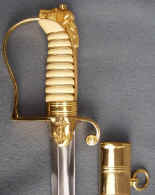 SWD-050 |
1805 Pattern Royal Navy Officer's Sword For more details on and images of this sword see:
|
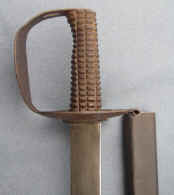 SWD-53 |
British 1804 Pattern Royal Navy Boarding Cutlass Prior to the famous naval battle of Trafalar, a new pattern of the Boarding cutlass was introduced. The popular 18th century design of the figure '8' iron hilt was retained but the horn or leather grip was wisely abandoned. The constant exposure to sea water, temperature and humidity fluctuations destroyed many a grip making the sword useless. In 1804 an iron grip was introduced, greatly extending the life of the cutlass. Historically there were variations of cutlasses produced including curved blades and scabbards with brass throat pieces and chapes. Because of the nature of naval warfare, these cutlasses eventually fell into the hands of other navies Britain was at war with. The British naval 'setbacks' during the War of 1812 would have caused a great volume of these swords being absorbed into the ranks of the U.S. Navy. This particular one is based on a surviving cutlass from the Battle of Lake Erie.
In 1814 a cutlass sword exercise or drill was developed for the Royal Navy sailor. While the image shows the 1805 pattern officer sword, the drill itself was meant for this cutlass: Additional Images: Image Image Image |
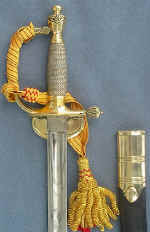
|
1796 Pattern Infantry Officer's Sword For more information and pictures click on the below link:
1796 Pattern Infantry Officer's Sword |
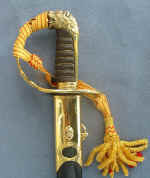 SWD-33 |
1803 Pattern Infantry Officer's Sabre For more information and pictures click on the below link:
1803 Pattern Infantry Officer's Sabre |
 SWD-35 & SWD-36 |
Sergeant and Drummer's Swords For more information and pictures click on the below link:
|
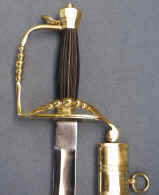
|
5-Ball Infantry Officer's Sword (Spadroon), 1780s-1800 Introduced in the 1780s this was considered the first attempt at a uniform pattern sword for the British Infantry. Called the 5-ball Spadroon because of the 5 ball decoration on the hilt, this pattern proved quite popular and even the French and American army officers adopted it as their own. The French nicknamed it the "epee anglaise" (English sword) and put it into action during the French Revolutionary Wars prior to Napoleon crowning himself emperor. British officers used a number of variations of the pattern including the one offered here. Additional Images: Image Image Image Image Image |
|
|
British Commonwealth Cavalry Officer's Sword (1912 Pattern) - Black Grip The last Cavalry officer's model to be adopted, the 1912 was designed after the Trooper's sword introduced in 1908. The hilt has a large nickel plated steel bowl decorated with beautiful scroll etching. The black grip is wire wrapped leather and has a very unique shape. Like with many on the other swords in our collection, the 35 1/2 inch blade is masterfully etched and well fullered. Completing the sword is a two ringed, nickel-plated steel scabbard. This sword is in high demand from various modern Commonwealth Cavalry regiments especially reserve units. It is an excellent quality sword at a reasonable price. Additional Images: Image 1 Image 2 Image 3 Now available British Sam Browne Pattern sword belt Brown or Black
|
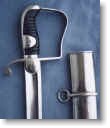
|
Pattern 1796 Light Cavalry Sabre. This is a beautiful sword with its wide sweeping blade and stirrup grip. It was indeed an extremely effective cutting sabre, so much so that the Prussians adopted it near the end of the Napoleonic wars. It also found favour with the United States. The US dragoon pattern for the War of 1812 was identical to this sword except the scabbard was blackened. This said it is most famous for its use by Britain's light dragoons and hussars in the Peninsular war and the Battle of Waterloo. The steel hilt of the reproduction is very well executed with smooth junctions. The black leather grip has very well defined ribbing making it a superior copy. The smart-looking 33 inch blade is made of high carbon "spring" steel. This sword comes with a well-constructed steel scabbard with two suspension rings. A great addition to your British sword collection! Do not let the amazingly affordable price fool you. This is a very well made sword.
|
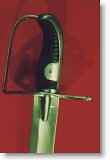
OUT OF STOCK SWD-12 |
Pattern 1796 Heavy Cavalry Sword (Sharpe's Sword !) Modeled after the Austrian 1775 pattern, this sword with its massive blade saw service with the British Dragoon Guards, etc. throughout the Napoleonic Wars. In recent times, this sword has been made famous by the author Bernard Cornwell in his novel series on a 95th Rifles officer by the name of Sharpe, who welds this relatively cumbersome weapon with great efficiency. One is amazed at the presence of this sword and the measures taken in its design to strengthen it. The steel, pierced guard and back strap are significantly reinforced as compared to other swords of the period. Finishing element of the hilt is the ribbed black leather grip. The blade is quite broad and this example has a diagonal cutting point to it, an improvement made by numerous regiments to increase the sword's efficiency. Completing the sword is a well crafted steel scabbard with extra-reinforced ring mounts.
|
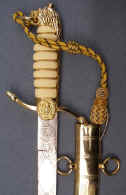
|
Victorian (pattern 1856) Royal Navy Midshipman's Dirk. This is an impressive weapon and much suited to the needs of the Midshipman, particularly if he has to maintain discipline below decks! This dirk with its 18 1/2 inch blade and double ringed scabbard must not have been a bother while the Midshipman negotiated his way through the close confines of his vessel. What catches your eye first is the hilt's loin's head pommel/back strap. Unlike the pattern 1827 naval sword, the lower jaw of the loin is quite visible as it clinches the sword knot ring in its teeth. The white wire-wrapped grip assists in bringing out the fine details of the hilt's sculpted pieces. There is no mistake it is naval with the badge of a crowned fouled anchor in laurels mounted on the languet area of the hilt. Finishing off the hilt are the decorative acorn finials at the ends of cross piece. Like the 1827 sword, the blade of the dirk is well decorated including a fouled anchor and royal coat of arms. The gilt fittings of the leather scabbard are all beautifully engraved. All the brass is gold plated with 24 carot Gold. One of the most interesting elements is the string steel catch which latches through the cross piece of the dirk's hilt, making it quite secure while performing the "naval acrobatics" of a seaman's duties. At the amazing price we are offering this piece, every naval enthusiast can afford one.
|
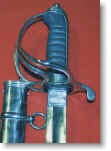 SWD-11  |
Pattern 1821/1822 Light Cavalry Trooper's Sabre. Five words covers the importance of this sword:Charge of the Light Brigade. When the 600 rode "on into the valley of death" at Balaklava this was on the the sabres being carried. However the dramatic actions in the Crimea was not the first time this sabre saw service. One event that comes to mind was the daring charge of the 3rd Light Dragoons against Sikh positions at Mudkee in 1845. So successful was the charge that the Sikh nick-named the 3rd "The Devil's Children". This all steel sabre is wonderfully executed. The three bar guard sits well into the pommel which is capped by a top nut. The grip is covered with imitation fish skin and wrapped with steel wire. The 31 1/4 inch blade is well fulled and the steel scabbard is of excellent quality. With its gold cord and acorn sword knot (sold separately), this will make a handsome addition to your collection. Additional Images: Sword with Scabbard Close up of Hilt Hilt |
 SWD-10 |
Model 1822/1845 Infantry Officer's Sword. This sword is the modified version of the 1822 pattern when the folding guard was officially discontinued and the back of the blade became flat, opposed to the 1822 piped-back blade. This sword saw incredible service in the 19th century including the Crimean War, the American Civil War, Boer War (unofficially) and the Zulu, Australian, New Zealand and Indian Colonial Conflicts. It was officially replaced in 1897 with a new pattern Infantry sword. During the American Civil War, not only did the British observers have this side arm but Confederate officers paid top dollar for one. One British observer noted in 1863: "In Houston, I myself saw an English regulation infantry sword exposed for sale for $225." Our price is in fact less today than its price over 130 years ago! Even the Mexican Army used this sword as early as the Battle of the Alamo. The stories around this sword are too numerous for this short description. The sword itself has a gothic type hilt with the Royal Cypher on the guard. The brass backstrap/pommel piece is finely detailed, and is finished with a pommel nut at the top. The grip is leather wrapped with twists of wire. In addition the 32 1/2 inch blade is masterfully etched with the appropriate devices. Completing the sword is its two ringed brass and leather scabbard.
|
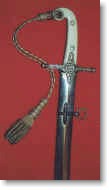
|
1831 British General Officer's Sabre. This sword is a 1831 pattern British General Officer's Sword. However its hilt is a complete copy of a Marshal's Mameluke style sword complete with crossed sword and Marshal's baton. Only after close examination of the etching on its 33 inch high carbon steel blade can you tell it is British. As with many of Napoleon's high ranking officers, the British Army's sword fashion was quite influence by its service in the Egyptian Campaign and there are numerous depictions and examples of unofficial models of the Mameluke sabre in the British service during the Napoleonic Wars. This is an absolutely beautifully constructed sword complete with elegantly executed brass scabbard with reinforced sling rings.
|
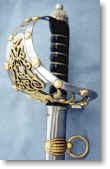
|
Victorian Life Guard's Officer Dress Sword. The post-Crimean War period brought a flurry of changes to the regimental patterns of swords carried by Britain's Heavy Cavalry. Included in this was the adoption of a variation of the 1st Life Guards 1834 pattern sword by the 2nd Life Guards in 1865. Officially sanctioned in 1872, this sword was carried by this famous regiment through the Boer War and WWI until 1922 when the 1st and 2nd Life Guards were amalgamated. This did not end the life of this impressive pattern. Instead the "2" was dropped from the guard's ornamental cypher and it became the official state sword of the Life Guards. As the images will attest, the detailing on this replica is breath taking and the craftsmanship astounding. The steel guard with its ornamental cypher and brass studs is obviously streaking. The hilt is completed with a chequered pommel, a stepped back strap and a wire wrapped black grip. The 39 inch blade is well fullered and with the appropriate etching work for an elite unit officer. Completing this fine piece is its steel scabbard with brass mountings. This is an incredible piece and considering its price, a must for your collection.
|
|
Royal Artillery Officer's Sword |
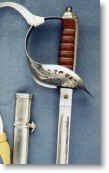
|
Historic 1897 Pattern Infantry Officer's Sword (Brown Grip). This pattern is almost identical to the 1895 pattern, except for a slightly turned down part of the base of the basket hilt that is close to the body. This sword is the pattern still carried today; the changing being the cypher of the reigning monarch. Some consider this model to be the best fighting sword ever issued to the British officer. The three-quarter pierced steel basket hilt provided maximum protection, while its 32 inch fullered blade made it an excellent thrusting edged weapon. Of course the blade also has the requisite finely executed etching. Completing the sword is its two ringed steel scabbard. Now available British Sam Browne Pattern sword belt
|
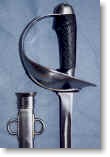 SWD-21 |
1908 Pattern Cavalry Trooper's Sword. Beautiful in its simplicity, the 1908 pattern offered the cavalryman a light weight sword with maximum protection, hand comfort, and thrusting ease. The sword's hilt consists of a steel bowl guard, a simulated rubber grip, and steel pommel. The blade is made of high carbon steel and is e 35 1/2 inches long. The steel scabbard has a two ring suspension system.
|
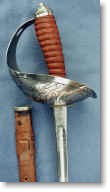
|
1912 Pattern Cavalry Officer's Sword - Brown Grip and Brown Scabbard. The last Cavalry officer's model to be adopted, the 1912 was designed after the Trooper's sword introduced in 1908. The hilt has a large nickel plated steel bowl decorated with beautiful scroll etching. The grip is wire wrapped leather and has a very unique shape. Like with many on the other swords in our collection, the 35 1/2 inch blade is masterfully etched. Completing the sword is its brown scabbard with steel chape (end piece). A must of the collector of World War I swords.
|
Shipping Information...
Destination
Shipping Time
Shipping Service
Shipping (One Sword)
Extra Sword add:
Canada
1 - 7 business days
UPS Standard
29 CAD
+ 9 CAD
United States
(excluding Hawaii and Alaska)4 - 7 business days
UPS Standard
29 US
+ 9 US
*United Kingdom
7 - 10 business days
UPS Expedited
89 US
+ 29 US
*Western and Northern Europe
7- 10 business days
UPS Expedited
89 US
+ 29 US
*Eastern Europe (Poland, Czech R., Slovak R., Hungary)
7-10 business days
UPS Expedited
149 US
+ 29 US
Other (Australia, New Zealand, Malta, etc)
Inquire
Inquire
Inquire
Shipping times are after your order has been processed.
*$CAD prices for Canadian residents only. All other country clients are charged in US Dollars.
*There are some remote territories of countries that have an additional shipping fee (client notified if an issue)
UPS (United Parcel Service) is a package courier: ups.com
Taxes, Duties, Restrictions, etc... For Canadian residents please add GST or HST (if applicable to your province). For United States residents there is no duty, restrictions, brokerage fees, or taxes on your sword orders when shipped through UPS.
All countries with shipping rates listed above can import our swords into their country (however there may be taxes and customs fees to pay). Other International clients please contact your customs department to determine fees, taxes, and restrictions. When inquiring to your government please note that the sword you wish to import is a historic replica and has no sharp edges. We have shipped our swords to over 18 different countries.
© Copyright 1995-2023: Unless otherwise noted, all information, images, data contained within this website is protected by copyright under international law. Any unauthorized use of material contained here is strictly forbidden. All rights reserved. Access Heritage Inc (formerly The Discriminating General) is in no way to be held accountable for the use of any content on this website. See Conditions of Use.